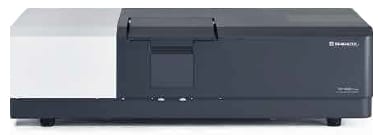Measurement of Solar Transmittance through Plate Glass
In recent years, various types of functionally enhanced glass with heat-blocking properties have been used in windows to inhibit the transmission of infrared light, as one way to combat global warming, the heat island effect, and other problems. JIS regulates solar transmittance as an index of the transmission characteristics of sunlight, which includes visible to near-infrared light. In this example, several types of glass were measured using a UV-3600 UV-VIS-NIR spectrophotometer and their solar transmittance was calculated using solar transmittance software.
Transmittance through five types of commercially sold plate glass (5 mm thick) was measured over the wavelength range from 250 nm to 2500 nm. The results show that while the clear glasses transmit all wavelengths above 350 nm well, the three types of heat-absorbing glass had a lower transmittance level than clear glass in the near-infrared region.
Based on these transmittance spectra, solar transmittance measurement software was used to calculate solar transmittance and visible light transmittance values. The results indicated that the heat-absorbing glasses with relatively low transmittance for both visible and near-infrared regions had the lowest solar transmittance values. A formula similar to the formula on the previous page was used to calculate visible light transmittance in the range of 380 nm to 780 nm, which is regulated along with solar transmittance by JIS R 3106 Testing method on transmittance, reflectance and emittance of flat glasses and evaluation of solar heat gain coefficient. Visible light transmittance values indicate a transmittance level that takes into consideration the human eye’s sensitivity to light.

Transmittance Spectra of Five Types of Glass
| Sample Name | Solar Transmittance (τe) | Visible Light Transmittance (τν) |
|---|---|---|
| Clear Glass 1 | 81.412 | 88.733 |
| Clear Glass 2 | 89.612 | 91.339 |
| Heat Absorbing Glass 1 | 47.428 | 75.051 |
| Heat Absorbing Glass 2 | 44.367 | 43.323 |
| Heat Absorbing Glass 3 | 52.023 | 50.029 |
Solar Transmittance and Visible Light Transmittance of Samples
UV-3600i Plus UV-VIS Spectrophotometer

Solar transmittance is defined as the ratio of solar radiation perpendicularly incident on window glass that is transmitted through the glass and calculated according to a formula specified in JIS R 3106 Testing method on transmittance, reflectance and emittance of flat glasses and evaluation of solar heat gain coefficient.
Solar transmittance measurement software* is used to calculate solar transmittance (or reflectance) values from transmittance (or reflectance) spectra according to the specified formula.
- * This software can only be used to calculate values for single panes of glass and cannot be used for multiple panes of glass.




